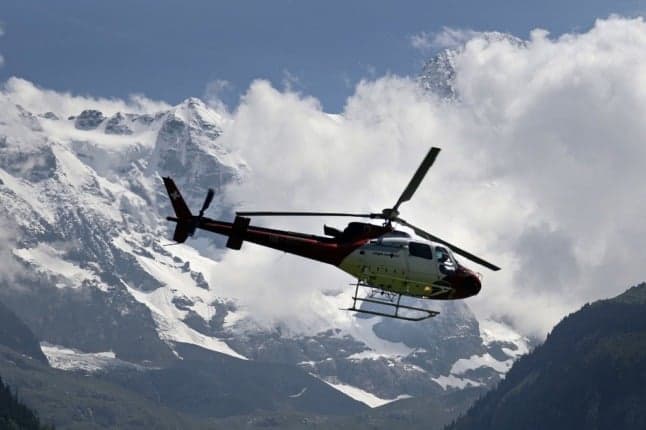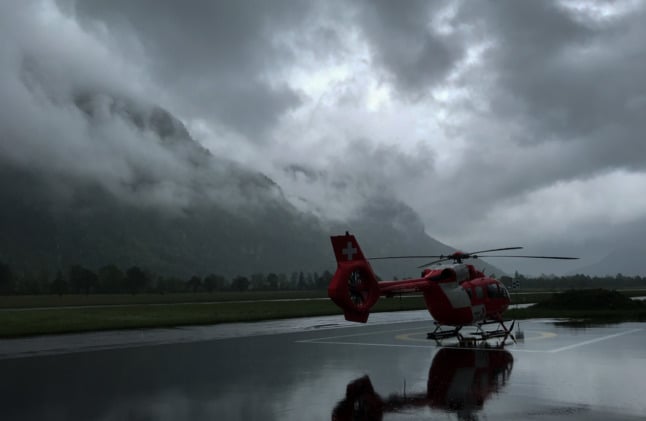Rega: What you need to know about Switzerland's air rescue service

While you will hopefully never need to use its services, it’s good to know that in case of a sudden illness or injury, you can be airlifted to a hospital from practically anywhere in Switzerland.
If you have lived in Switzerland for a while, you have probably heard of Rega, or possibly seen its white-and-red helicopters on mountain slopes, tending to and evacuating injured skiers.
A unique service operating in Switzerland and neighbouring Liechtenstein, Rega is a rescue organisation with seven decades of experience.
Here’s what this air rescue service, also referred to as “air ambulance”, is all about.
COMPARE: What Covid rules are in place for the ski season across Europe?
What is Rega?
Rega, is a non-profit mountain rescue service which is primarily catered to mountain areas.
Rega primarily helps skiers, hikers and other winter sport enthusiasts in difficult terrain and mountain areas.
Rega's name is taken from the German and French versions of 'Swiss Air Rescue': Schweizerische Rettungsflugwacht, French: Garde aérienne suisse de sauvetage.
Rega was founded in 1952 with a team of parachutists trained in England.
Rega is not associated with the Swiss government and therefore does not receive any government funding. Instead, it operates on a subscription model.
UPDATED: What are the Covid rules on Swiss ski slopes this winter?
How many helicopters does Rega have and where are they stationed?
There are 18 rescue helicopters on 12 bases located throughout Switzerland. This means that even the most remote areas can be reached within minutes.
As at November 2021, Rega has more than 300 full and part-time employees.
In what situations are Rega rescue helicopters deployed?
Most often a helicopter, and its crew consisting of a pilot, emergency doctor and paramedic, responds in case of illness or accidents in places that are not accessible to land ambulances — for instance, in the mountains.
https://www.youtube.com/watch?v=MApdSbLQ5Zs
They are also used to airlift patients from one hospital to another.
Such cases were frequent during the first wave of the pandemic in 2020, when Rega was charged with transferring Covid patients from overcrowded ICUs to other medical facilities within Switzerland.
Around the clock, seven days a week
Even when Swiss Air Force worked on a reduced schedule — from 8am to 6pm, Monday to Friday, with weekends off — Rega was on duty 24 hours a day, seven days a week, and remains so to this day.
This way, it can respond to emergencies at any hour of day or night, and in all kinds of weather.

Rega helicopters can handle any type of weather conditions. Photo: Rega
However, keep in mind that a rescue helicopter may not be readily available just when you need it, if they all happen to be deployed at the same time.
To call Rega in Switzerland, dial 1414.
What happens if you have an accident abroad? Will Rega come to get you?
According to Rega website, it can “organise and execute medical evacuations and medically escorted repatriations from virtually any country in the world” back to Switzerland thanks to its three long-range Challenger 650 ambulance-jets, which are fitted out as intensive-care units.
The number to call from abroad is +41 333 333 333.
Winter sports: Which Swiss ski resorts are already open?
How is Rega financed?
It is a non-profit service funded by donations from its members, who are called “patrons”. Rega currently has more than 11,000 patrons in Switzerland.
Membership fees vary depending on whether one person joins or the entire family, but while these contributions keep Rega afloat, they don’t entitle donors to a free ride.
Rega membership starts at CHF40 for individuals and rises to CHF80 for families.
Does it mean you have to foot the rescue bill yourself?
As Rega explains on its website, it can “at its own discretion and within the bounds of its resources, waive or reduce the costs of any emergency services” if health or accident insurance doesn’t pay for this service.
Does Swiss health insurance cover Rega’s services?
An airlift can cost thousands of francs unless, as stated above, Rega agrees to wave part of its costs.
Basic compulsory insurance only pays 50 percent of these costs.
However, many supplementary insurance policies will cover the rest, as will some travel insurances.
More information about Rega and the kind of services it provides can be found here.
READ MORE: Should you buy supplemental health insurance in Switzerland?
Comments
See Also
If you have lived in Switzerland for a while, you have probably heard of Rega, or possibly seen its white-and-red helicopters on mountain slopes, tending to and evacuating injured skiers.
A unique service operating in Switzerland and neighbouring Liechtenstein, Rega is a rescue organisation with seven decades of experience.
Here’s what this air rescue service, also referred to as “air ambulance”, is all about.
COMPARE: What Covid rules are in place for the ski season across Europe?
What is Rega?
Rega, is a non-profit mountain rescue service which is primarily catered to mountain areas.
Rega primarily helps skiers, hikers and other winter sport enthusiasts in difficult terrain and mountain areas.
Rega's name is taken from the German and French versions of 'Swiss Air Rescue': Schweizerische Rettungsflugwacht, French: Garde aérienne suisse de sauvetage.
Rega was founded in 1952 with a team of parachutists trained in England.
Rega is not associated with the Swiss government and therefore does not receive any government funding. Instead, it operates on a subscription model.
UPDATED: What are the Covid rules on Swiss ski slopes this winter?
How many helicopters does Rega have and where are they stationed?
There are 18 rescue helicopters on 12 bases located throughout Switzerland. This means that even the most remote areas can be reached within minutes.
As at November 2021, Rega has more than 300 full and part-time employees.
In what situations are Rega rescue helicopters deployed?
Most often a helicopter, and its crew consisting of a pilot, emergency doctor and paramedic, responds in case of illness or accidents in places that are not accessible to land ambulances — for instance, in the mountains.
https://www.youtube.com/watch?v=MApdSbLQ5Zs
They are also used to airlift patients from one hospital to another.
Such cases were frequent during the first wave of the pandemic in 2020, when Rega was charged with transferring Covid patients from overcrowded ICUs to other medical facilities within Switzerland.
Around the clock, seven days a week
Even when Swiss Air Force worked on a reduced schedule — from 8am to 6pm, Monday to Friday, with weekends off — Rega was on duty 24 hours a day, seven days a week, and remains so to this day.
This way, it can respond to emergencies at any hour of day or night, and in all kinds of weather.

Rega helicopters can handle any type of weather conditions. Photo: Rega
However, keep in mind that a rescue helicopter may not be readily available just when you need it, if they all happen to be deployed at the same time.
To call Rega in Switzerland, dial 1414.
What happens if you have an accident abroad? Will Rega come to get you?
According to Rega website, it can “organise and execute medical evacuations and medically escorted repatriations from virtually any country in the world” back to Switzerland thanks to its three long-range Challenger 650 ambulance-jets, which are fitted out as intensive-care units.
The number to call from abroad is +41 333 333 333.
Winter sports: Which Swiss ski resorts are already open?
How is Rega financed?
It is a non-profit service funded by donations from its members, who are called “patrons”. Rega currently has more than 11,000 patrons in Switzerland.
Membership fees vary depending on whether one person joins or the entire family, but while these contributions keep Rega afloat, they don’t entitle donors to a free ride.
Rega membership starts at CHF40 for individuals and rises to CHF80 for families.
Does it mean you have to foot the rescue bill yourself?
As Rega explains on its website, it can “at its own discretion and within the bounds of its resources, waive or reduce the costs of any emergency services” if health or accident insurance doesn’t pay for this service.
Does Swiss health insurance cover Rega’s services?
An airlift can cost thousands of francs unless, as stated above, Rega agrees to wave part of its costs.
Basic compulsory insurance only pays 50 percent of these costs.
However, many supplementary insurance policies will cover the rest, as will some travel insurances.
More information about Rega and the kind of services it provides can be found here.
READ MORE: Should you buy supplemental health insurance in Switzerland?
Join the conversation in our comments section below. Share your own views and experience and if you have a question or suggestion for our journalists then email us at [email protected].
Please keep comments civil, constructive and on topic – and make sure to read our terms of use before getting involved.
Please log in here to leave a comment.